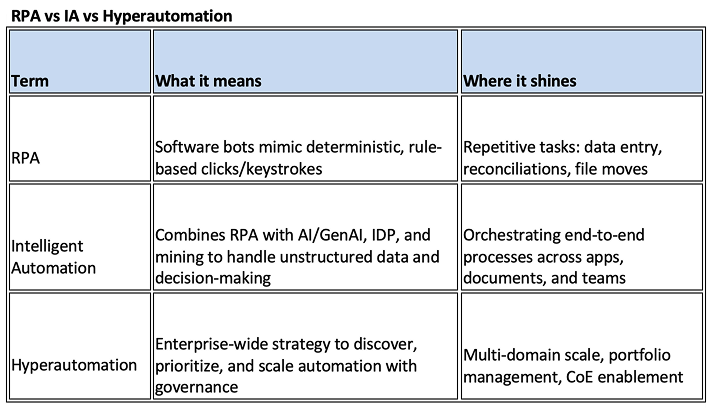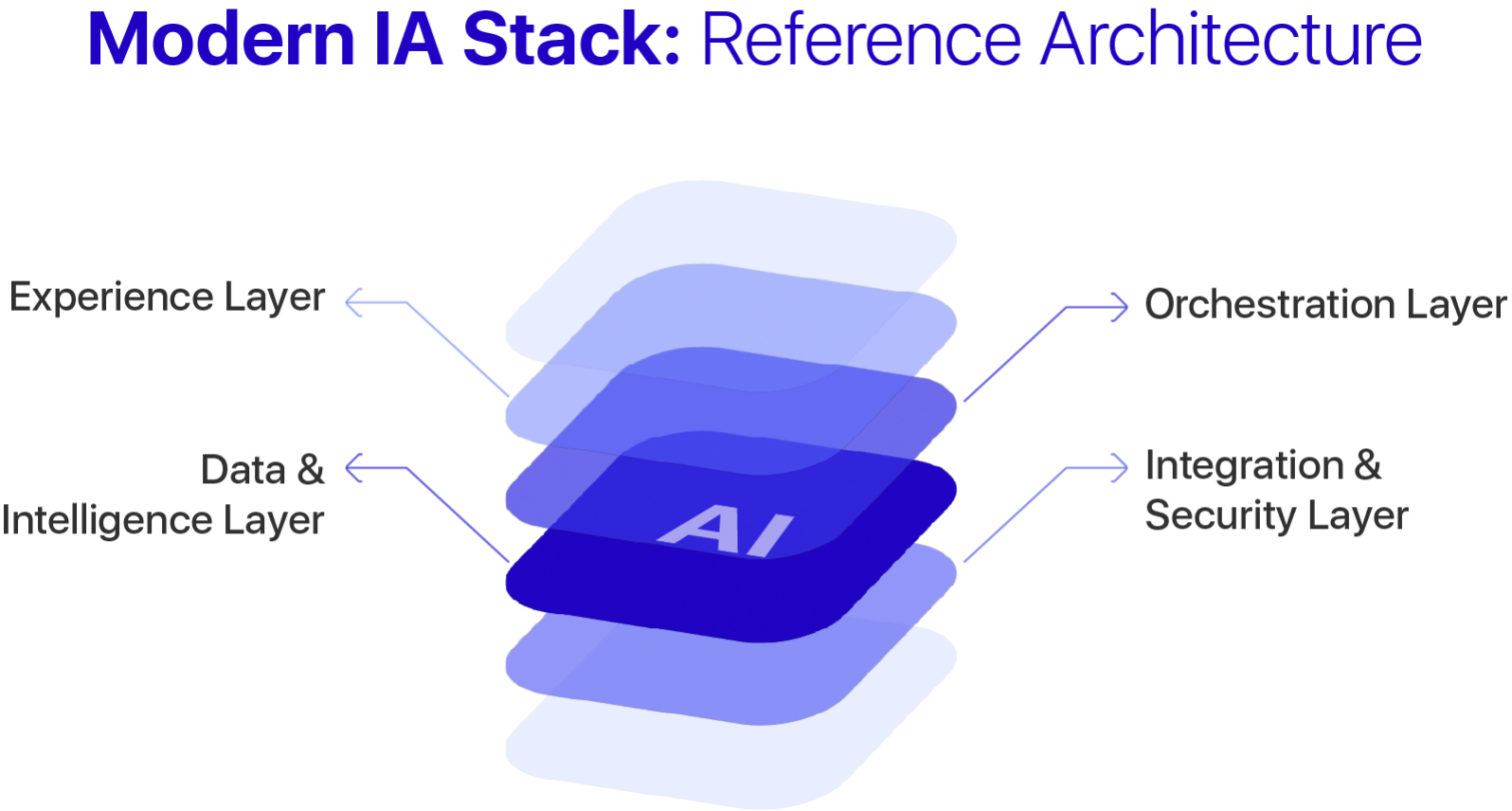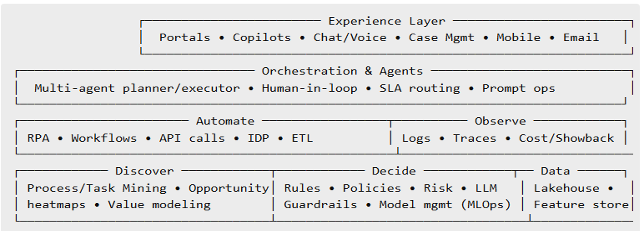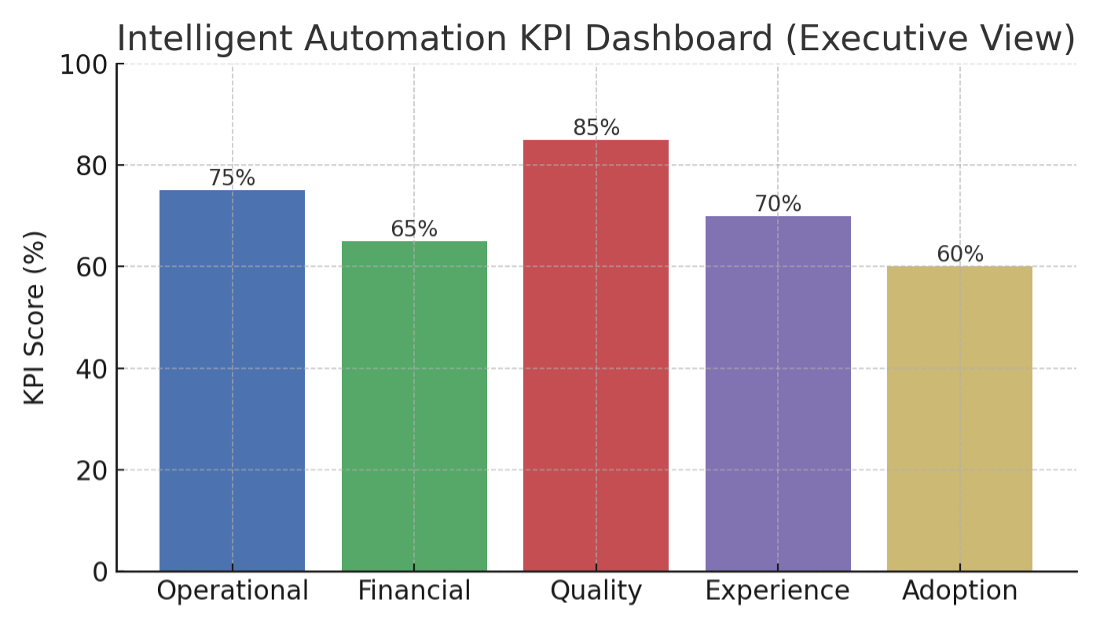The Age of Agentic Automation: How Intelligent Automation is Transforming Enterprises in 2025 and Beyond
Summary
Intelligent Automation (IA) has evolved far beyond traditional RPA, it’s now the operating system of agentic enterprises. By combining AI/GenAI agents, RPA, process mining, and low-code orchestration, businesses can unlock measurable outcomes: faster cycle times, lower cost-to-serve, improved customer experiences, and compliance by design.
In 2025, enterprises that embrace agentic automation where specialized AI agents collaborate with people and systems will set the pace for digital transformation. This guide shares a reference architecture, a 90-day implementation playbook, ROI models, and PureSoftware accelerators for enterprise adoption.
1. What is Intelligent Automation?
Intelligent Automation (IA) is the disciplined integration of:
- Robotic Process Automation (RPA)
- Artificial Intelligence / GenAI
- Process and task mining
- Low-code orchestration
Unlike basic task automation, IA enables enterprises to automate end-to-end processes across silos spanning applications, documents, and human interactions while embedding governance and continuous optimization.

The 5 pillars of IA-
1. Discover: Process mining, task mining, opportunity heatmaps, value modeling
2. Decide: Predictive ML, business rules, policy engines, guardrails
3. Do: RPA, scripts, APIs, workflow engines, intelligent document processing
4. Dialogue: Chat/voice agents, copilots, multi agent orchestration
5. Deliver: Observability, analytics, cost/showback, continuous improvement
Design principle: Automate the handoffs and decisions, not just tasks. True efficiency comes from eliminating friction between teams, systems, and decisions.
2. Why Intelligent Automation now: Market Shifts You Can’t Ignore
The automation landscape has entered an agentic era, driven by maturity in GenAI, process intelligence, and low-code ecosystems.
-
From Chatbots to Agents: GenAI has evolved from simple conversational tools to autonomous agents that plan tasks, invoke APIs, interpret documents, and know when to involve humans.
-
Process Intelligence Goes Mainstream: Mining + telemetry + decision models now create adaptive business systems that tune themselves in real time.
-
Low-Code Integration Accelerates Delivery: Unified API and governance frameworks allow enterprises to scale securely.
-
Compliance Pressure Is Real: Regulatory frameworks demand auditable, policy-driven automation, IA helps codify compliance into workflows.
Key Insight: Task automation is no longer enough.
Enterprises must orchestrate people, AI agents, and apps together, the new baseline for transformation in 2025.
3) Outcomes That Matter: ROI You Can Defend
Modern enterprises no longer automate merely to cut costs, they automate to scale value, enhance resilience, and elevate customer experience.
Agentic Intelligent Automation (IA) drives measurable outcomes that leadership teams can model, forecast, and confidently defend.
Proven Business Impact
-
Faster cycle times
In document-heavy workflows (claims, onboarding, KYC), programs commonly report up to ~70–75% faster processing, depending on complexity and exception rates.¹ -
Lower cost-to-serve
At scale, organizations report ~25–30% average cost reduction from intelligent automation, driven by reduced manual effort and better orchestration.² -
Accelerated payback
Payback periods typically improve from ~15 months in pilots to ~9 months at scale as adoption expands across functions.² -
Revenue growth
Longitudinal executive surveys attribute ~10–12% revenue uplift over three years to cross-functional automation initiatives.² -
High financial ROI in finance ops
In AP/AR/reconciliation use cases, empirical studies show median first-year ROI >150%, fueled by error reduction, faster throughput, and lower rework.¹
References:
-
Financial Process Automation impact studies (ResearchGate compilations, 2024).
-
Automation with Intelligence, global executive survey series (Deloitte, latest editions).
Together, these outcomes redefine ROI not as cost savings alone, but as a blueprint for scalability, resilience, and enterprise transformation.

4) Modern IA Stack: Reference Architecture
To fully capture automation’s value, enterprises must view it as an end-to-end ecosystem, not isolated bots or workflows.
The Modern Intelligent Automation Stack provides the blueprint for building scalable, compliant, and AI-driven operations.
Think of Intelligent Automation as a layered ecosystem:
- Experience Layer – The interface for employees, customers, and AI copilots through chat, voice, and self-service portals.
- Orchestration Layer – The “brain” coordinating RPA bots, GenAI agents, APIs, and human handoffs in real time.
- Data & Intelligence Layer – Combines process mining, telemetry, and decision intelligence to optimize workflows continuously.
- Integration & Security Layer – Connects ERPs, CRMs, and core systems with built-in governance, identity management, and audit controls.
⚡ Core Advantage: This unified stack connects fragmented automations into a cohesive, measurable system of value, enabling adaptability, observability, and scalability at enterprise scale.


5) Priority Use Cases by Industry
Intelligent Automation delivers the highest impact where documents, decisions, and compliance converge.
Here’s how top industries are deploying agentic AI systems for measurable transformation:
- Banking & Financial Services – Transform KYC/AML, loan origination, and credit operations with GenAI-driven Intelligent Document Processing (IDP) to extract data, detect anomalies, and strengthen compliance.
→ Result: Up to 70% faster onboarding and reduced manual verification errors. - Healthcare & Life Sciences – Accelerate claims adjudication, lab report extraction, and adverse event monitoring through IA copilots and process mining insights.
→ Result: Improved accuracy, reduced rework, and faster regulatory compliance. - Manufacturing & Supply Chain – Leverage IA for supplier onboarding, predictive maintenance case creation, and documentation automation to build resilient operations.
→ Result: Enhanced uptime and traceability across supply networks. - Retail & E-Commerce – Automate catalog onboarding, refund workflows, and customer service copilots to improve agility and personalization.
→ Result: Reduced manual effort, faster resolutions, and stronger customer loyalty. - Telecom & Media – Automate network provisioning, incident triage, and billing queries using AI agents that handle volume spikes efficiently.
→ Result: Resolution times reduced by up to 60–90%. - Public Sector – Digitize benefits adjudication, licensing, and citizen service triage with automation that enforces SLAs and transparency.
→ Result: Streamlined service delivery and enhanced citizen experienc
💡 Pattern Insights: For maximum ROI, start where documents meet decisions processes with high compliance, SLA dependency, and manual verification.
6) LLM Powered Automation Patterns: From Reactive to Agentic
- Retrieval-Augmented Automation (RAA)
Agents access policy and knowledge bases before acting, ensuring every decision is explainable and traceable.
Example: Claims processing bots cite policies directly in approvals. - Intelligent Document Processing 2.0 (IDP 2.0)
Combines Vision-Language Models (VLMs), OCR, and layout understanding with human-in-the-loop (HITL) validation for confidence thresholds below 80%.
Outcome: 95%+ data accuracy in forms, KYC, and invoices. - Tool-Calling Agents
AI agents invoke secure internal APIs (ERP, CRM, Core Systems) via allow-listed connectors, enabling governed automation.
Result: Controlled autonomy without compromising compliance. - Supervisor–Worker Multi-Agent Systems
A supervisory agent decomposes tasks and delegates them to worker agents; human review triggers on ambiguity or PII risk.
Outcome: Reliable scale with safety. - Autonomous Test-and-Fix Loops
Agents self-generate test data, validate automation flows, and auto-heal broken selectors or prompts, reducing downtime and manual QA.
Takeaway: LLM-driven automations move enterprises from static workflows to self-learning ecosystems, improving accuracy, speed, and resilience.
7) Governance, Risk & Security: Building Trust by Design
As automation grows more autonomous, governance becomes the true differentiator.
PureSoftware emphasizes security, transparency, and auditability in every IA deployment embedding compliance into the automation pipeline itself.
Governance Principles for Agentic IA
-
-
Policies as Code: Data retention, access, and redaction are encoded into every workflow, ensuring continuous compliance.
-
PromptOps Framework: Version-controlled prompts with unit and regression testing prevent prompt injection and drift.
-
Human-in-the-Loop Controls: Risk-based thresholds require human validation for sensitive actions like payments, PHI, or KYC approvals.
-
AI RMF Alignment: Adheres to frameworks for fairness, transparency, and robustness, ensuring traceable AI decisions.
-
Regional Regulations: Compliance baked in for DPDP (India), GDPR (EU), HIPAA (US health), and PCI DSS (payments).
-
Supply Chain Integrity: Model provenance checks, vetted datasets, and SBOMs (Software Bill of Materials) maintain ecosystem trust.
PureSoftware’s Governance Edge: Every automation solution is secure-by-design, auditable, and ready for multi-region deployment.
-
8) A Proven 90 Day Roadmap
Transforming enterprise operations with Intelligent Automation doesn’t have to take years.
90-day agentic automation playbook helps organizations identify value, build confidence, and scale securely — fast.
Days 0–15 → Discover & Align
-
Conduct process and task mining for 2–3 high-impact workflows.
-
Establish baseline metrics (AHT, FTE impact, SLA breaches).
-
Map risk and compliance dependencies to business value.
Days 16–45 → Pilot & Build
-
Deploy orchestration layer and configure 1–2 GenAI agents.
-
Integrate case management, SSO, and HITL workflows.
-
Set confidence thresholds and test governance pipelines.
Days 46–75 → Run & Tune
-
Progress from shadow runs → limited production → scaling.
-
Add telemetry for latency, confidence scores, and ROI counters.
-
Harden prompts, selectors, and decision logs for accuracy.
Days 76–90 → Scale & Center of Excellence (CoE)
-
Extend automation to two more processes.
-
Establish a governance board and automation backlog.
-
Train citizen developers and publish automation runbooks.
Result: A measurable, compliant, and scalable IA foundation within 90 days, from proof-of-concept to production value.

9) Measuring Success: The Metrics That Matter
Intelligent Automation success isn’t just about automation volume, it’s about business value realization.
The most mature enterprises measure automation performance through multi-dimensional KPIs spanning efficiency, cost, quality, experience, and adoption.
Key Performance Indicators (KPIs)
Operational Efficiency
-
Average Handling Time (AHT)
-
Cycle Time Reduction
-
First Contact Resolution Rate
-
SLA Compliance
Financial Impact
-
Cost per Case / per 1,000 Transactions
-
Run Cost vs. Value Realized
-
Payback Period and ROI Multiplier
Quality & Accuracy
-
Exception Rate and Error Reduction %
-
Audit Findings / Compliance Violations
-
Model Drift & Rework Trends
Experience Metrics
-
Customer Satisfaction (CSAT) & Net Promoter Score (NPS)
-
Employee Effort Score
-
AI Agent Containment Rate
Adoption & Maturity
-
Processes Automated
-
Bot and Agent Utilization Rates
-
Citizen Developer Participation
Insight: Intelligent Automation drives the greatest value when success is measured beyond efficiency, linking KPIs directly to customer experience, revenue impact, and governance maturity.

10) Build vs. Buy vs. Hybrid: Choosing the Right IA Model
-
Buy: When Speed & Compliance Matter
Leverage established platforms with built-in connectors, guardrails, and governance to reduce setup time and ensure compliance.
Best for regulated industries like BFSI, Healthcare, and Public Sector. -
Build: When Differentiation Defines You
Custom-build domain copilots and proprietary automation flows that align with your organization’s unique IP, customer models, and workflows.
Best for enterprises seeking a competitive edge through innovation. -
Hybrid: The Enterprise Reality
Combine the best of both worlds — enterprise platforms + custom AI agents.
Ensure portability across RPA tools and LLM models through open APIs and abstraction layers, so you’re never locked into a single vendor.PureSoftware Recommendation:
Hybrid automation wins. It enables governed innovation accelerating deployment without sacrificing ownership or compliance.
11) PureSoftware POV: Accelerators for Agentic Automation
PureSoftware helps enterprises transform vision into execution with accelerators, toolkits, and governance frameworks that simplify the automation journey.
Our Proven Accelerators
-
Automation Discovery Pack: 2-week engagement for process mining, opportunity heatmaps, and ROI modeling.
-
Agentic Starter Kit: Prebuilt templates for supervisor/worker agents, prompt registries, and policy packs.
-
IDP Blueprints: Ready-to-deploy models for invoices, KYC, claims, onboarding, and contract processing.
-
Orchestration Layer: Includes case management, HITL workflows, audit trails, and cost telemetry.
-
Governance Toolkit: Aligns with AI RMF and DPDP/GDPR controls for safe, transparent automation.
-
RunOps 24×7: Continuous monitoring, prompt/selector tuning, and cost optimization.
Why Enterprises Choose PureSoftware?
- Outcomes-First Approach: We begin with the value tree and tie every initiative to measurable ROI counters.
- Security by Design: Policies-as-code and auditable pipelines ensure compliance from day one.
- Domain Expertise: Proven accelerators for BFSI, Healthcare, Telecom, and Manufacturing deliver faster time-to-value.
- Scalable Partnership: From pilot to CoE, we empower organizations to automate confidently and responsibly.
Call to Action:
Connect with us to explore how Agentic Intelligent Automation can deliver measurable ROI for your business – https://www.puresoftware.com/contact-us
Frequently Asked Questions
-
What should we automate first?
Document heavy flows with clear SLAs, frequent hand offs, and measurable volume. -
How do we manage model & prompt drift?
Version everything; regression test prompts; set confidence thresholds; track outcomes. -
Will IA replace jobs?
IA shifts work from swivel chair tasks to expert decisions, reducing burnout and errors. -
How do we keep regulators comfortable?
Keep a policy mapped audit trail, HITL for high risk actions, and PII minimization/redaction. -
How do we avoid vendor lock in?
Use a tool agnostic orchestration layer and abstract LLMs via adapters.

